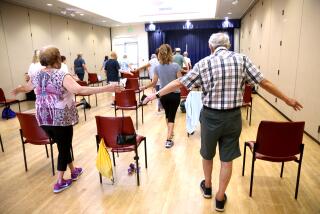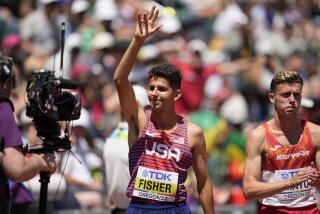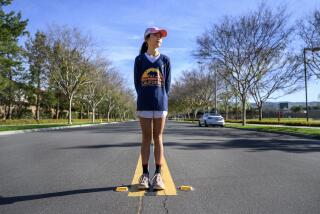Toward a Middle-Age Spurt : RUNNING AND RACING AFTER 35 <i> by Allan Lawrence and Mark Scheid (Little, Brown and Co.: $10.95; 288 pp.; 0-316-51675-9) </i>
- Share via
“Let us run with patience the race that is set before us.” (Hebrews 13:1)
While St. Paul had another race in mind, his admonition to be patient may be of particular comfort to the runner who can no longer take adolescent limbs for granted. “Running and Racing After 35” not only counsels patience, but especially offers encouragement and hope.
Allan Lawrence and Mark Scheid, who also co-authored “The Self-Coached Runner” and “The Self-Coached Runner II,” examine the problems and issues facing runners over the age of 35, especially the “master runner,” which in competition is the designation generally given to runners over the age of 40.
They introduce this volume with a discussion of what it means to be an “older athlete.” It has been commonly thought (at least in this country) that once one has truly reached the age of wisdom and maturity--approximately the mid-20s, popular wisdom has it--one ought to hang up one’s athletic gear and allow the trophies and dreams to rust in their nostalgic grandeur.
Lawrence and Scheid instead insist that what has been described as the “peak years” for athletes must be redefined. They point, for instance, to the glorious example of the Portuguese runner Carlos Lopes, who at age 36 ran off with the 1984 Olympic gold medal in the marathon. Numerous other examples can be found among master competitors in distances ranging from 800 and 1500 meters to 10,000 meters and the marathon. It is only a matter of time, they point out, before master runners break four minutes for the mile--a goal for which the famed Jim Ryun himself is training.
In the face of such evidence, it is clear that age does not necessarily define one’s athletic limits. It is possible, the authors say, to lead a normal professional life and maintain a high level of competitive training without succumbing to societal pressures to “let the things of youth” pass by. Naturally, the over-35 runner has several areas he must pay more attention to than the runner of 20--such as stretching exercises and dietary changes--and the authors incorporate these potential problem areas in their discussions.
The authors have concentrated on the most popular competitive distances of 5 kilometers, 10Ks and marathon. They offer training programs for top competitors as well as for runners who either have no interest in setting records or who (like most of us) realistically cannot make records other than personal ones.
Hence, for the 5K, schedules are given for the sort of training necessary to race in 14 minutes, 30 seconds, all the way up to 30 minutes; the 10K schedules begin with training for a 31-minute race and continue to 58 minutes; marathon schedules stretch from 2 hours, 25 minutes to 4 hours, 50 minutes.
The training consists of reasonable track workouts combined with road work: Track develops the runner’s speed while road training focuses on endurance. The final chapter of the book offers a variety of questions asked by older runners and the authors’ answers and suggestions.
Lawrence and Scheid have written an enjoyable and informative book. They are realistic in confronting problems to which the over-30 or 40-year-old may be prone. Yet they stress that one need not have begun running in one’s early 20s in order to succeed in whatever personal goal one sets. Who can fail to be inspired by their stories of Priscilla Welsh, who began to run in her 30s and finished a marathon in 2:26 when she was in her 40s? Or by Derrick Turnbull, who ran a 2:37 marathon in the South Australian championships at age 60? On the other hand, the authors offer good solid advice and help to the majority of runners whose goals are far more modest.
I should add that this book is designed for the self-coached runner; one need not have a personal or professional coach to reach the goals described. The main emphasis of the authors is that one need not despair at growing older but work with one’s body and outline realistic mental and physical goals which overcome any of the “disadvantages” of leaving behind the follies of youth. “Running and Racing After 35” reads easily, is well-organized and is a refreshing addition to the literature devoted to masters’ athletics.
More to Read
Go beyond the scoreboard
Get the latest on L.A.'s teams in the daily Sports Report newsletter.
You may occasionally receive promotional content from the Los Angeles Times.






